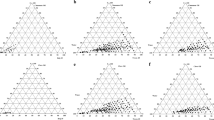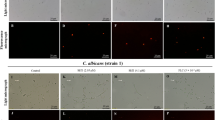Abstract
The objective of our studies is the development of a novel formulation of nystatin (NYT) that could be administered systemically and might be used for therapy of invasive mycoses. We developed a formulation of nystatin and intralipid (IL), which is a clinically used food supplement, and this report focuses on the characterization of NYT-IL, assessment of its antifungal activity and in vitro toxicity. We characterized physical properties of the NYT-IL preparation and its stability during storage. Susceptibility of Candida, Aspergillus and Fusarium species was determined using a CLSI technique. In vitro toxicity of NYT-IL was assessed using an assay measuring hemolysis of sheep red blood cells (SRBC) and leakage of potassium. It was found that: (1) the particle size in NYT-IL did not differ from that of IL; (2) over 80% of NYT was in association with IL; and (3) these features did not change during storage. All Candida and Aspergillus strains had lower minimal inhibitory concentration (MIC) values for NYT-IL than that for NYT; the MICs of the Fusarium strains were similar for NYT & NYT-IL. Toxicity assays showed that the NYT-IL formulation is less toxic than NYT. In conclusion, we describe a novel, characterized, stable formulation of nystatin, nystatin-intralipid, with in vitro activity against pathogenic Candida and Aspergillus species.





Similar content being viewed by others
References
Perlroth J, Choi B, Spellberg B. Nosocomial fungal infections: epidemiology, diagnosis, and treatment. Med Mycol. 2007;45:321–46.
Wisplinghoff H, Bischoff T, Tallent SM, Seifert H, Wenzel RP, Edmond MB. Nosocomial bloodstream infections in US hospitals: analysis of 24, 179 cases from a prospective nationwide surveillance study. Clin Infect Dis. 2004;39:309–17.
Kauffman CA. Fungal infections. Proc Am Thorac Soc. 2006;3:35–40.
Richardson MD, Warnock DW. Antifungal drugs. In: Fungal infection. Diagnosis and management. Blackwell; 2000. p. 29–79.
Zhang AY, Camp WL, Elewski BE. Advances in topical and systemic antifungals. Dermatol Clin. 2007;25:165–83.
Kleinberg M. What is the current and future status of conventional amphotericin B? Int J Antimicrob Agents. 2006;27(Suppl 1):12–6.
Ng AW, Wasan KM, Lopez-Berestein G. Development of liposomal polyene antibiotics: an historical perspective. J Pharm Pharmaceut Sci. 2003;6:67–83.
Shadkhan Y, Segal E, Bor A, Gov Y, Rubin M, Lichtenberg D. The use of commercially available lipid emulsions for the preparation of amphotericin B-lipid admixtures. J Antimicrob Chemother. 1997;39:655–8.
Sionov E, Segal E. Treatment of murine systemic aspergillosis with polyene-intralipid admixtures. Med Mycol. 2004;42:73–80.
Sionov E, Segal E. Polyene and cytokine treatment of experimental aspergillosis. FEMS Immunol Med Microbiol. 2003;39:221–7.
Shadkchan Y, Segal E. Antifungal activity of amphotericin B-lipid admixtures in experimental systemic candidosis in naive mice. J Antimicrob Chemother. 1999;44:787–90.
Shadkchan Y, Segal E. Treatment of experimental candidosis with amphotericin B-Intralipid admixtures in immunocompromised mice. J Antimicrob Chemother. 2001;48:245–51.
Shadkchan Y, Zaslavsky Z, Segal E. Pharmacokinetics of amphotericin B in serum and tissues in mice treated with amphotericin B-Intralipid. Med Mycol. 2003;41:15–9.
Shadkchan Y, Keisari Y, Segal E. Cytokines in mice treated with amphotericin B-intralipid. Med Mycol. 2004;42:123–8.
Moreau P, Milpied N, Fayette N, Ramée JF, Harousseau JL. Reduced renal toxicity and improved clinical tolerance of amphotericin B mixed with intralipid compared with conventional amphotericin B in neutropenic patients. J Antimicrob Chemother. 1992;30:535–41.
Washington C, Lance M, Davis SS. Toxicity of amphotericin B emulsion formulations. J Antimicrob Chemother. 1993;31:806–8.
Chavanet P, Clement C, Duong M, Buisson M, D’Athis P, Dumas M, et al. Toxicity and efficacy of conventional amphotericin B deoxycholate versus escalating doses of amphotericin B deoxycholate—fat emulsion in HIV-infected patients with oral candidosis. Clin Microbiol Infect. 1997;3:455–61.
National Committee for Clinical Laboratory Standarts. Reference method for broth dilution antifungal susceptibility testing of yeasts. Approved standard M27-A. NCCLS, Wayne, PA, USA, 1997.
National Committee for Clinical Laboratory Standarts. Reference method for broth dilution antifungal susceptibility testing of filamentous fungi. Approved standard M38-A. NCCLS, Wayne, PA, USA, 1997.
Souza LC, Maranhao RC, Schreier S, Campa A. In vitro and in vivo studies of the decrease of amphotericin B toxicity upon association with a triglyceride-rich emulsion. J Antimicrob Chemother. 1993;32:123–32.
Lass-Flörl C, Griff K, Mayr A, Petzer A, Gastl G, Bonatti H, et al. Epidemiology and outcome of infections due to Aspergillus terreus: 10-year single centre experience. Br J Haematol. 2005;131:201–7.
Hachem RY, Kontoyiannis DP, Boktour MR, Afif C, Cooksley C, Bodey GP, et al. Aspergillus terreus: an emerging amphotericin B-resistant opportunistic mold in patients with hematologic malignancies. Cancer. 2004;101:1594–600.
Kuriyama T, Williams DW, Bagg J, Coulter WA, Ready D, Lewis MA. In vitro susceptibility of oral Candida to seven antifungal agents. Oral Microbiol Immunol. 2005;20:349–53.
Arikan S, Ostrosky-Zeichner L, Lozano-Chiu M, Paetznick V, Gordon D, Wallace T, et al. In vitro activity of nystatin compared with those of liposomal nystatin, amphotericin B, and fluconazole against clinical Candida isolates. J Clin Microbiol. 2002;40:1406–12.
Oakley KL, Moore CB, Denning DW. Comparison of in vitro activity of liposomal nystatin against Aspergillus species with those of nystatin, amphotericin B (AB) deoxycholate, AB colloidal dispersion, liposomal AB, AB lipid complex, and itraconazole. Antimicrob Agents Chemother. 1999;43:1264–6.
Johnson EM, Ojwang JO, Szekely A, Wallace TL, Warnock DW. Comparison of in vitro antifungal activities of free and liposome-encapsulated nystatin with those of four amphotericin B formulations. Antimicrob Agents Chemother. 1998;42:1412–6.
Sutton DA, Sanche SE, Revankar SG, Fothergill AW, Rinaldi MG. In vitro amphotericin B resistance in clinical isolates of Aspergillus terreus, with a head-to-head comparison to voriconazole. J Clin Microbiol. 1999;37:2343–5.
Ledbetter EC, Patten VH, Scarlett JM, Vermeylen FM. In vitro susceptibility patterns of fungi associated with keratomycosis in horses of the northeastern United States: 68 cases (1987–2006). J Am Vet Med Assoc. 2007;231:1086–91.
Tzatzarakis MN, Tsatsakis AM, Charvalos E, Vakalounakis D. Comparison of in vitro activities, clotrimazole, econazole, miconazole, and nystatin against Fusarium oxysporum. J Environ Sci Health. 2001;36:331–40.
Author information
Authors and Affiliations
Corresponding author
Additional information
In partial fulfillment toward the Ph.D degree by R. Semis.
Rights and permissions
About this article
Cite this article
Semis, R., Polacheck, I. & Segal, E. Nystatin-Intralipid Preparation: Characterization and In Vitro Activity Against Yeasts and Molds. Mycopathologia 169, 333–341 (2010). https://doi.org/10.1007/s11046-009-9271-z
Received:
Accepted:
Published:
Issue Date:
DOI: https://doi.org/10.1007/s11046-009-9271-z




